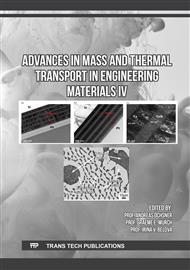[1]
Lilja, C., King, F., Puigdomenech, I., and Pastina, B., 2021. Speciation of copper in high chloride concentrations, in the context of corrosion of copper canisters. Materials and Corrosion.; 72:293–299
DOI: 10.1002/maco.202011778
Google Scholar
[2]
Kizaki, T., O, M., and Kajihara, M., 2020. Rate-Controlling Process of Compound Growth in Cu-Clad Al Wire during Isothermal Annealing at 483–543 K. Materials Transactions, 61, 1: 188. https://www.jstage.jst.go.jp/article/matertrans/61/1/61_MT-M2019207/_html/-char/en
DOI: 10.2320/matertrans.mt-m2019207
Google Scholar
[3]
Yarmolenko, M. V., 2022. Copper, Iron, and Aluminium Electrochemical Corrosion Rate Dependence on Temperature. In F. Zafar, A. Ghosal, & E. Sharmin (Eds.), Corrosion - Fundamentals and Protection Mechanisms, 35-50. IntechOpen. https://doi.org/10.5772/ intechopen.100279
DOI: 10.5772/intechopen.100279
Google Scholar
[4]
Yarmolenko, M. V., 2021. Intrinsic Diffusivities Ratio Analysis in Double Multiphase Systems. Defect and Diffusion Forum, 413: 47–64. https://doi.org/10.4028/www.scientific.net/ ddf.413.47
DOI: 10.4028/www.scientific.net/ddf.413.47
Google Scholar
[5]
YarmolenkoM. V. (2020). Copper and aluminum electric corrosion investigation and intermetallics disappearance in Cu-Al system analysis. Physics and Chemistry of Solid State, 21(2), 294-299
DOI: 10.15330/pcss.21.2.294-299
Google Scholar
[6]
YarmolenkoM. (2021). Intermetallics Disappearance Rates and Intrinsic Diffusivities Ratios Analysis in the Cu-Zn and the Cu-Sn Systems. Physics and Chemistry of Solid State, 22(1), 80-87
DOI: 10.15330/pcss.22.1.80-87
Google Scholar
[7]
Payak, V., Paulraj, J., Roy, B.S. et al. Microstructural and mechanical characteristics of friction stir welded Al6101/C11000 joints with zinc and silver interlayer. Int J Adv Manuf Technol (2023)
DOI: 10.1007/s00170-023-11839-7
Google Scholar
[8]
Amina Othmani, Abudukeremu Kadier, Raghuveer Singh, Chinenye Adaobi Igwegbe, Mohamed Bouzid, Md Osim Aquatar, Waheed Ahmad Khanday, Million Ebba Bote, Fouad Damiri, Ömür Gökkuş, Farooq Sher. A comprehensive review on green perspectives of electrocoagulation integrated with advanced processes for effective pollutants removal from water environment. Environmental Research, 215(1), 2022: 114294
DOI: 10.1016/j.envres.2022.114294
Google Scholar
[9]
Brahmi Khaled, Bouguerra Wided, Hamrouni Béchir, Elaloui Elimame, Loungou Mouna, Tlili Zied. Investigation of electrocoagulation reactor design parameters effect on the removal of cadmium from synthetic and phosphate industrial wastewater. Arabian Journal of Chemistry, 2019, 12(8): 1848-1859
DOI: 10.1016/j.arabjc.2014.12.012
Google Scholar
[10]
Dong-hyo Kim, Dongwoo Lee, Damián Monllor-Satoca, Kitae Kim, Woojin Lee, Wonyong Choi. Homogeneous photocatalytic Fe3+/Fe2+ redox cycle for simultaneous Cr(VI) reduction and organic pollutant oxidation: Roles of hydroxyl radical and degradation intermediates. Journal of Hazardous Materials, 2019, 372:121-128. https://doi.org/10.1016/j.jhazmat. 2018.03.055
DOI: 10.1016/j.jhazmat.2018.03.055
Google Scholar
[11]
Barak Morgan, Ori Lahav. The effect of pH on the kinetics of spontaneous Fe(II) oxidation by O2 in aqueous solution – basic principles and a simple heuristic description, Chemosphere, 68, 2007, 11:2080-2084
DOI: 10.1016/j.chemosphere.2007.02.015
Google Scholar
[12]
Ratnesh Kumar Patel, Ravi Shankar, Prateek Khare, Prasenjit Mondal. Treatment of sugar processing industry wastewater using copper electrode by electrocoagulation: Performance and economic study. Journal of the Indian Chemical Society, 99(8), 2022: 100563
DOI: 10.1016/j.jics.2022.100563
Google Scholar
[13]
Beverskog, B. and Pettersson, S.-O., 2002. Pourbaix Diagrams for Copper in 5 m Chloride Solution. SKI Report 02: 23. https://www.stralsakerhetsmyndigheten.se/contentassets/ 4b1ef76c4151413998c76becb6da0570/0223-pourbaix-diagrams-for-copper-in-5-m-chloride-solution-pdf-320-kb
Google Scholar
[14]
Fan L, Wang F, Wang Z, Hao X, Yang N, Ran D. Study on the Influence of Surface Treatment Process on the Corrosion Resistance of Aluminum Alloy Profile Coating. Materials. 2023; 16(17): 6027
DOI: 10.3390/ma16176027
Google Scholar
[15]
Skarboviychuk, O. M., Ovcharuk, V. O., and Fedorov, V. G., 2008. Empirical functions of thermophysical characteristics of NaCl solutions as a function of temperature and concentration. Food industry, 7, 111-113 (in Ukrainian). http://dspace.nuft.edu.ua/jspui/bitstream/123456789/1320/3/7-36.pdf
Google Scholar
[16]
C.S. Goh, W.L.E. Chong, T.K. Lee, and C.Breach (2013). Corrosion Study and Intermetallics Formation in Gold and Copper Wire Bonding in Microelectronics Packaging. Crystals, 3(3): 391. https://www.mdpi.com/2073-4352/3/3/391
DOI: 10.3390/cryst3030391
Google Scholar
[17]
Jinshui Cheng, Linxiao Wu, Jingshan Luo; Cuprous oxide photocathodes for solar water splitting. Chem. Phys. Rev. 2022; 3 (3): 031306
DOI: 10.1063/5.0095088
Google Scholar
[18]
Olasunkanmi, O. L., 2022. Corrosion: Favoured, Yet Undesirable - Its Kinetics and Thermodynamics. Corrosion - Fundamentals and Protection Mechanisms: 15-33
DOI: 10.5772/intechopen.98545
Google Scholar
[19]
Mogilei, S., Honcharov, A., Tryus, Y. (2023). Solving Multimodal Transport Problems Using Algebraic Approach. In: Faure, E., Danchenko, O., Bondarenko, M., Tryus, Y., Bazilo, C., Zaspa, G. (eds) Information Technology for Education, Science, and Technics. ITEST 2022. Lecture Notes on Data Engineering and Communications Technologies, vol 178. Springer, Cham
DOI: 10.1007/978-3-031-35467-0_6
Google Scholar


